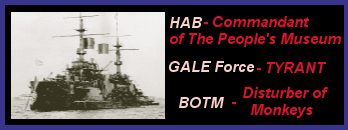Great Harry:
186 guns, 44 of which are what we would consider "cannons", including a couple monster 66 pdrs.
142 swivel guns, purely anti-personel devices.
1000 ton carrack built in 1514.
The scenario is in harbor, dead calm conditions at 400 yard's range.
On whom do you place your money?
(edit) I know there've been a couple Constitution threads, but I've wanted to do this for while. So why not while everyone's thinking wood.....err, not THAT wood.
